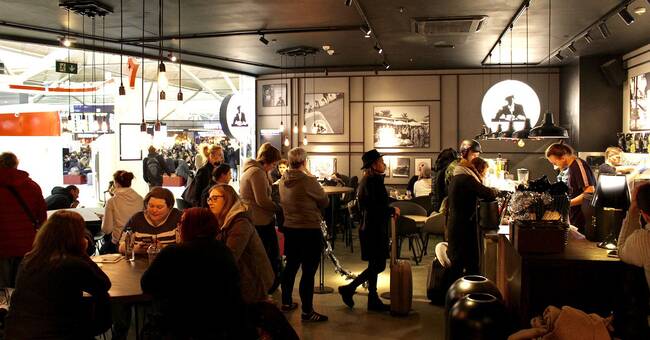On January 24 last year, 89 guests sat down to lunch at a restaurant in Guangzhou, China.
At three tables next to each other, a total of nine people were infected by one and the same person.
It happened on a floor where there were no windows and the air conditioning did not take in any new air from outside but the same air circulated around.
This, combined with the fact that the air currents were constantly changing due to the heat from the guests and the food, created good conditions for the spread of covid-19.
Green guest came to the restaurant infected with covid-19.
The red guests became infected at the restaurant.
The blue dots represent virus particles.
Photo: Jiarong Hong, University of Minnesota
The infection takes unexpected paths
The outbreak of covid-19 at the restaurant in Guangzhou is seen as proof that the infection can occur through the air.
A new study shows in detail how the infection may have spread through different air currents in the restaurant.
Among other things, the researchers conclude that the infection may have taken unexpected paths, such as under a table.
But as in many other studies, researchers make several assumptions that differ from reality.
- The study assumes that no changes take place in the restaurant at the time of infection, for example that everyone is sitting still in their place and that the temperature in the restaurant is unchanged.
In reality, the air currents change when a person gets up or a door is opened, says Jakob Löndahl who is a senior lecturer and associate professor of ergonomics and aerosol technology at Lund University.
Sitting further away is no guarantee
Several researchers have concluded that airborne particles of SARS-CoV-2, which cause covid-19, can be spread over longer distances in the air than single meters.
One of the researchers is Åke Lundkvist, professor of virology at the Department of Medical Biochemistry and Microbiology at Uppsala University.
He has conducted a study on how far virus particles spread in the air.
It is published in the scientific journal Nature Scientific Reports.
- The particles in the air that spread viruses from the exhaled air vary greatly in number and size.
A larger particle does not follow the air currents in the same way as a small one.
A small particle probably contains fewer virus particles, but can, as it seems, remain in the air for longer, says Åke Lundkvist.
WHO writes that a well-maintained air conditioning where air is taken in from outside can reduce the spread of infection indoors.
Jakob Löndahl agrees.
- If you feel that the air is heavy and trapped, the ventilation is not good.
Where the ventilation has its exhaust matters less, the most important thing is that the air supply is good.
Fresh air can be achieved with good ventilation in the room or with the help of air purifiers but also through open doors or windows.
It makes a big difference to the spread and therefore it is difficult to say where to sit in a restaurant, he says.
The sound level and how long you are in the room matters
Both Jakob Löndahl and Åke Lundkvist believe that restaurants are a place where the risk of infection for covid-19 is quite high.
This is because you often sit for a long time and talk.
If a person carrying the infection is in the room, virus particles in the air can be transmitted after only half an hour.
The particles are generated by speech and breathing from an infected person and can remain in the air for several hours.
- The louder you talk, sing or scream, the more particles and drops are excreted from the airways, says Åke Lundkvist.
If you still go to a restaurant during the pandemic, Jakob Löndahl suggests that you choose one where you are not so crowded, the sound volume is low and the ventilation is good.
- These results can also be applied to cars, cramped offices or meeting rooms and poorly ventilated training rooms.
Even if the air is exchanged in the car, for example, it is a cramped space where you often talk quite loudly, says Jakob Löndahl.

